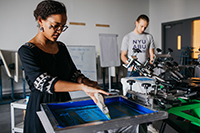A leading science journal has published award-winning chemistry research by a student from NYU Abu Dhabi that could revolutionize how energy is generated and consumed.
The paper, co-authored by NYUAD Postdoctoral Associate Lidong Zhang, NYUAD Class of 2014 graduate Haoran Liang, Associate Professor of Chemistry at Abu Dhabi University Jolly Jacob, and NYUAD Associate Professor of Chemistry Panče Naumov, was published by Nature Communications on June 11.
The research served as Haoran’s senior Capstone project, and earned him first prize in chemistry at the 2014 UAE Undergraduate Research Awards.
Publication in Nature Communications is a significant acknowledgment not only for the authors but for smart materials research at NYUAD, led by Professor Naumov. Since the project began a little over two years ago, dozens of students and postdoctoral researchers have been working to develop polymers, or small pieces of film, that respond to external stimuli, like heat, light or pressure. These types of so-called smart materials could ultimately provide unlimited power and efficient energy conversion and storage, the key to major sustainability advances and development of alternative energy.
Salaam spoke with one of the authors, Haoran, at Columbia University, where he's attending graduate school.
How did you start studying this material?
In the summer before my senior year, I was looking for a research topic that would eventually lead to my Capstone project. I have been interested in smart materials so I contacted Professor Naumov, got some papers about the topic, and started reading.
What is useful about smart materials that respond to external stimuli?
Nature gives us plenty of resources and inspirations. We were inspired by the tendrils of climbing plants which can grow in response to sunlight and to humidity. The smart material we made is humidity driven and can be remotely controlled by UV light, which could potentially be utilized in various applications including medical prosthetics and smart biomimetics.
What are you doing at Columbia?
I am currently working on a project that has to do with property analysis of 2D nano-materials such as bilayer M0S2. It is not similar to what I did at NYUAD, but the skills and experience that I gained at NYUAD really helps me in my research at Columbia.
Why did you become a chemist?
I think chemistry is beautiful because it is not only a process of gathering particles, but also an art of triggering interactions among them. In real life, I see the acquisition of knowledge as the process of gathering particles, but what's more important is the way I utilize it. Any piece of knowledge alone is insufficient to create something new, but different pieces together, when properly utilized, will eventually become necessary components to solve the puzzle.
Related articles:
Molecules Inspired by Nature (The National)
Humidity-driven movement (Nature Middle East)


